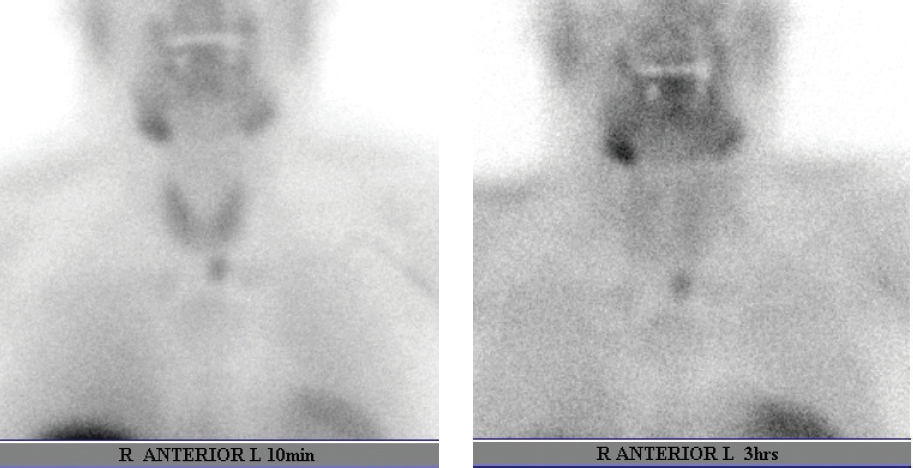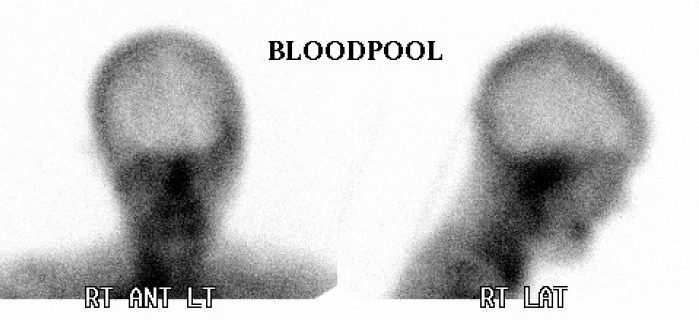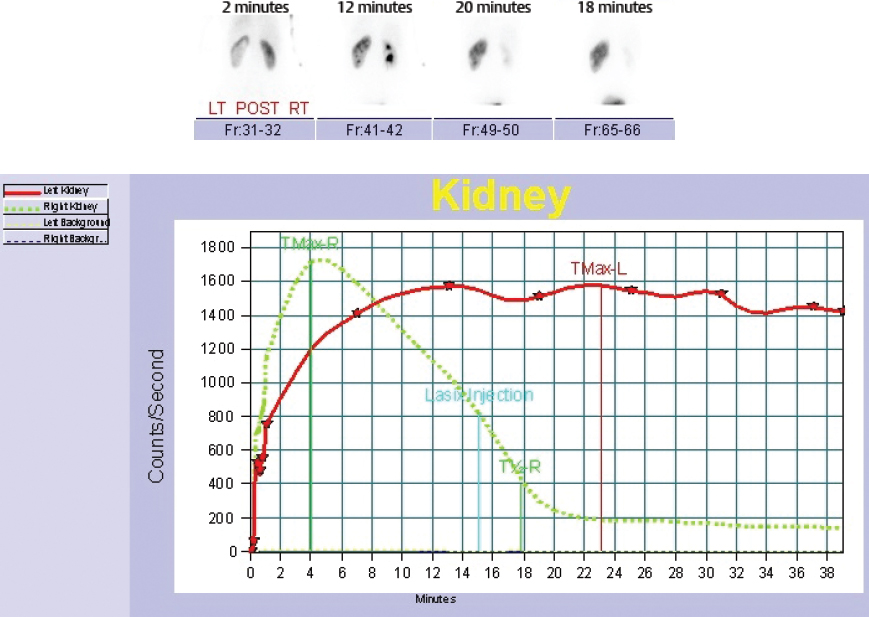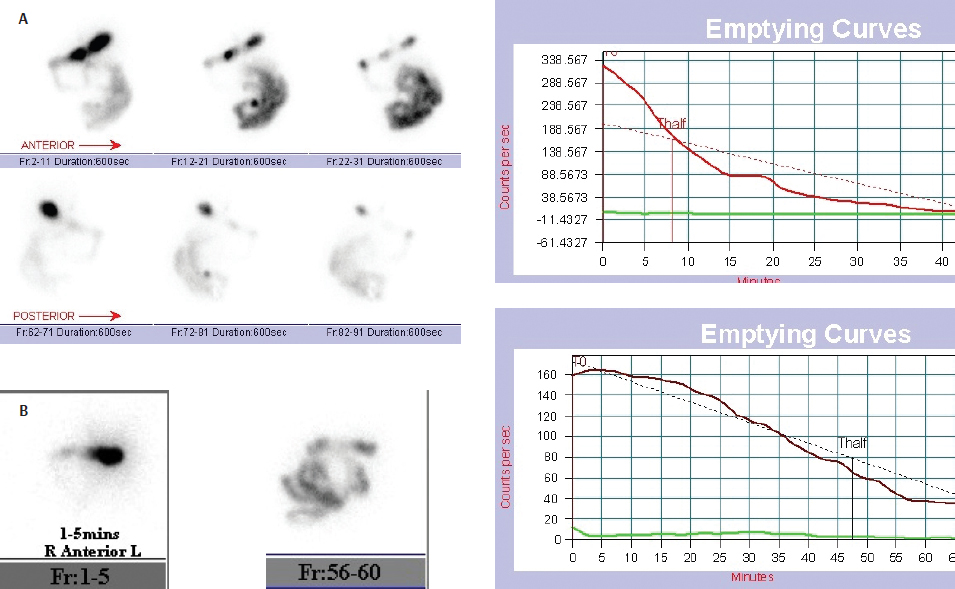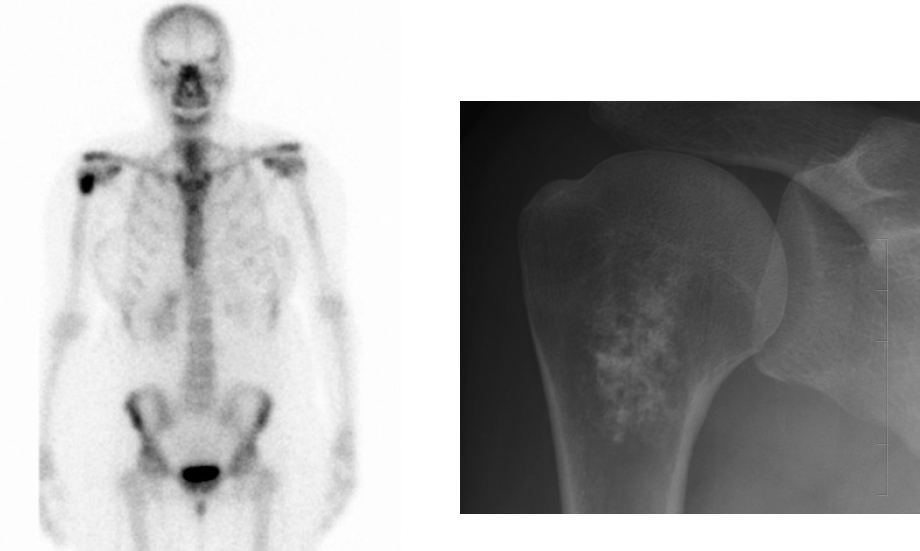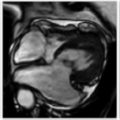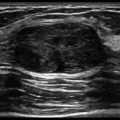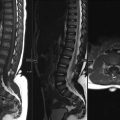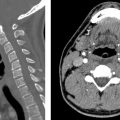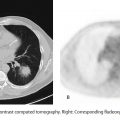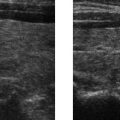SECTION IX NUCLEAR MEDICINE IMAGING
Essentials 1
Case
The tech brings you a hepatobiliary scan (ordered for acute cholecystitis) to check for completion of the exam. The surgeon is anxious to operate if the patient has acute cholecystitis.
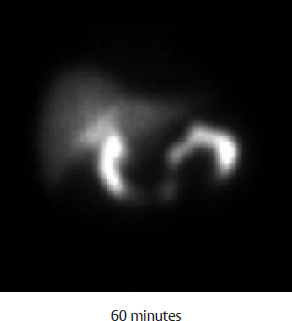
Questions
1. Based on the 60-minute image, which ONE of the following is the best next course of action?
A. Obtain delayed images.
B. Ask for different views.
C. Administer water.
D. Take no action. The study is complete.
E. Give pharmacologic intervention.
2. Regarding hepatobiliary scintigraphy and cholecystitis, which ONE of the following is correct?
A. Chronic cholecystitis usually demonstrates delayed gallbladder filling.
B. Hepatobiliary scanning is less sensitive for the detection of acalculous cholecystitis than it is for calculus cholecystitis.
C. Enterogastric reflux after cholecystokinin administration implies symptomatic pathology.
D. The rim sign is typically associated with early stage acute cholecystitis.
E. If patient has eaten within the last 8 hours, the study should be delayed.
3. Regarding hepatobiliary scintigraphy, biliary dyskinesia, and/or sphincter of Oddi dysfunction, which ONE of the following is correct?
A. Both cholecystokinin and fatty meal challenge have similar efficacy in diagnosing biliary dyskinesia.
B. The most physiologic mimic with cholecystokinin infusion is a slow injection over a 3-minute period, followed by 30 minutes of scanning.
C. An abnormal gallbladder ejection fraction is predictive of a good clinical response to cholecystectomy.
D. A sphincter of Oddi protocol is used precholecystectomy to determine if sphincterotomy will be needed.
E. To prevent a false-positive study for acute cholecystitis, morphine should be held prior to hepatobiliary scanning.
Answers and Explanations
Question 1
E. Correct! Giving pharmacologic intervention is the best next course of action. (The gallbladder has not filled, so the study is not complete.) The options for confirming filling of the gallbladder include (1) delayed imaging after 3 more hours (total of 4 hours postinjection) or (2) intravenous administration of morphine sulfate followed by 30 additional minutes of imaging. Morphine results in temporary spasm of the sphincter of Oddi (SOD;, facilitating flow through a patent cystic duct into the gallbladder. With either option, if the gallbladder does not fill, the study is positive for acute cholecystitis. Morphine administration permits the most rapid confirmation of acute cholecystitis.
Other choices and discussion
A. Radiotracer overlies both the common bile duct and gallbladder, and it is not clear that the gallbladder has filled. Visualization of the gallbladder confirms patency of the cystic duct and essentially excludes acute cholecystitis. Delayed imaging (performed immediately, 2 to 3 hours later, or even at 18 to 24 hours in the setting of severe hepatocellular dysfunction) is commonly performed when the gallbladder is not seen at 60 minutes. However, as the surgeon is seeking the fastest diagnosis, delayed images are not the best answer.
B. Anterior images are standard. At 60 minutes and with further delay, additional left anterior oblique and right lateral views are usually recommended. However, varying camera positioning at 60 minutes would not clarify the diagnosis in this case.
C. The patient must remain nothing by mouth (NPO) except for water throughout the study to avoid stimulating endogenous cholecystokinin (CCK) and subsequently contracting the gallbladder. Water will not stimulate CCK and helps to clear away unwanted duodenal radiotracer, which better displays the gallbladder. However, giving water would not confirm the diagnosis in this case.
D. The most common indication for a HIDA scan (as in this case) is to assess for acute cholecystitis, and that diagnosis cannot be confirmed at this point.
Question 2
B. Correct! hepatobiliary (HIDA) scanning is less sensitive for the detection of acalculous cholecystitis than it is for calculus cholecystitis. The sensitivity of HIDA scanning for acalculous cholecystitis is 80% (versus 97% for the more “typical” calculus cholecystitis).
Other choices and discussion
A. The HIDA scan is most commonly normal in the setting of chronic cholecystitis, although delayed gallbladder visualization after 1 hour may be seen. In general, scintigraphic evaluation of chronic cholecystitis is less accurate than it is with acute cholecystitis.
C. Enterogastric reflux before CCK administration implies symptomatic pathology (bile gastritis). Make sure to look for this often overlooked sign. However, after CCK administration, enterogastric reflux may occur normally and does not need to be reported.
D. The rim sign is seen in 30% of patients with acute cholecystitis. However, this sign is associated with later stage acute cholecystitis, including gangrenous cholecystitis.
E. For the prep, remember 4 hours and 24 hours. The patient must be NPO for more than 4 hours (to allow the contracted gallbladder to subsequently relax and distend appropriately), and NPO for less than 24 hours, to prevent excessive stasis.
Question 3
C. Correct! An abnormal gallbladder ejection fraction (GBEF) is predictive of a good clinical response to cholecystectomy. To calculate, GBEF = [(net GB max) − (net GB min)/(net GB max)] × 100.
Other choices and discussion
A. Although fatty food does result in gallbladder contraction, no universally recognized numerical fatty food ejection fraction standards exist.
B. The most physiologic mimic with CCK is a slow intravenous push over 1 hour, generally accomplished with the aid of an injection device. Normal GBEF is ≥ 38%.
D. The SOD protocol is used postoperatively. About 10% of cholecystectomy patients have postoperative pain. SOD dysfunction behaves like a physiologic partial biliary obstruction after cholecystectomy. The SOD protocol scan takes into account numerous data points, collectively determining how well the radiotracer passes into the small bowel.
E. While it is true that narcotics should be held at least three half lives (or approximately 6 hours) prior to HIDA scanning, narcotics do not prevent gallbladder visualization. Narcotics delay bowel visualization through contraction of the SOD, mimicking a functional biliary obstruction.
Suggested Readings
Tulchinsky M, Ciak BW, Debelke D, et al. SNM practice guideline for hepatobiliary scintigraphy 4.0. J Nucl Med Technol 2010;38(4):210–218Top Tips
Cardiac blood pool activity usually clears rapidly with HIDA scanning (over 5 to 15 minutes). Prominent cardiac uptake still seen at 60 minutes suggests hepatocellular dysfunction.
The SOD protocol is used in the postcholecystectomy patient with pain to assess for functional delayed biliary clearance.
False-positive HIDA scan: NPO < 4 hours or > 24 hours, hepatic dysfunction, hyperalimentation, concurrent severe illness, and prior cholecystectomy.
Essentials 2
Questions
1. Which ONE of the following is correct?
A. Standard imaging for this study should include the neck and the entire chest.
B. This patient almost certainly has both an elevated parathyroid hormone level and an elevated serum calcium level.
C. The main utility of this sestamibi scan is to differentiate malignancy from primary hyperparathyroidism as the cause of this patient’s hypercalcemia.
D. This patient has a 5 to 10% chance of having more than one parathyroid adenoma.
E. In the neck, this sestamibi uptake is specific for a parathyroid adenoma.
2. Regarding the treatment for hyperparathyroidism, which ONE of the following correct?
A. Both medical and surgical treatment in this patient will result in similar outcomes.
B. If this patient has surgery, his chance of postoperative recurrence is 25%.
C. The surgeon will likely check intraoperative calcium levels to confirm surgical success.
D. With newer surgical technique, the need for preoperative scintigraphy has declined.
E. The parathyroid gland is sometimes surgically implanted into the forearm.
3. Regarding scintigraphy of hyperparathyroidism, which ONE of the following is correct?
A. The normal parathyroid glands are often seen with sestamibi scintigraphy.
B. The most common false-negative is a poorly vascularized adenoma.
C. The most common false-positive is a thyroid adenoma.
D. Several large studies have demonstrated the benefit of single-photon emission computed tomography over planar imaging.
E. A positive scintigraphic study must demonstrate a nodule with early increased activity and delayed washout (when compared to the thyroid gland).
Answers and Explanations
Question 1
D. Correct! The chance that this patient has more than one parathyroid adenoma is 5 to 10%. Additional adenomas are frequently missed on imaging, often because of their small size. (This study is positive for a parathyroid adenoma.)
Other choices and discussion
A. Standard imaging for this study should include the neck and the upper chest. The majority of parathyroid adenomas occur near the thyroid gland, but approximately 5% of adenomas are ectopic, occurring as high as the carotid bifurcation and low as the level of the pericardium. Adenomas may be seen retrotracheal, paracardiac, and rarely intrathyroidal. Imaging of the lower chest is not helpful, however.
B. Although the majority of patients do have concomitant parathyroid hormone (PTH) and serum calcium laboratory abnormalities, about 20% of patients have only one or the other lab abnormality at a time.
C. Malignancy (the second most common cause of hypercalcemia) is associated with suppressed PTH levels, whereas primary hyperparathyroidism (the most common cause of hypercalcemia) has normal or elevated PTH levels. By the time the patient is imaged, the diagnosis of hyperparathyroidism has very likely already been made. The scan is not primarily used to distinguish these entities.
E. Sestamibi is a perfusion agent, and adenomas have high vascularity. However, sestamibi uptake is nonspecific. It has been used with success to identify various malignant masses, including lung cancer, gliomas, and primary bone neoplasms. In addition, thyroid pathology may be seen with sestamibi.
Question 2
E. Correct! The gland is sometimes surgically implanted into the forearm. This is especially the case with hyperplasia surgery, where 3.5 glands are removed.
Other choices and discussion
A. Surgery is the treatment of choice.
B. Treatment is usually curative, although there is a reported 5% recurrence rate. Etiologies of recurrence include ectopic adenoma, failure to diagnose hyperplasia, and a fifth parathyroid gland. Reoperation has a worse outcome and greater morbidity, so it is important to diagnose correctly the first time.
C. The surgeon does measure intraoperative lab values. However, the PTH is measured, not the calcium. Success is defined as an intraoperative reduction of PTH by 50%. If that value is not achieved, further surgery is needed.
D. The more extensive standard bilateral neck exploration of the past had a high success rate (> 90%), and the need for preoperative localization for an initial surgery at that time was debated. However, new minimally invasive surgery permits a smaller neck exploration, and the need for preoperative localization has actually increased. Newer techniques lead to less complications and shorter operating room times.
Question 3
C. Correct! The most common false-positive is a thyroid adenoma. Thyroid cancer and parathyroid cancer may also mimic an adenoma on scintigraphy.
Other choices and discussion
A. Normal parathyroid glands are not seen. Visualization suggests pathology.
B. The most common false-negative is a small-sized adenoma. False-negatives may also be seen with a second adenoma or with four-gland hyperplasia.
D. No large studies have convincingly shown that single-photon emission computed tomography (SPECT) is better than planar imaging, although most experienced readers do believe that SPECT helps, especially with localization. One large study did compare early and delayed imaging with planar, SPECT, and SPECT/computed tomography; SPECT/computed tomography early with any type of delayed imaging was the best.
E. Although early increased activity and delayed washout is the most common parathyroid adenoma pattern, variations exist. For example, early washout may also occur. The key to making the diagnosis is to detect any focal perfusion abnormality in a suspicious area. Anatomic correlation is often helpful to confirm that the presumed parathyroid adenoma is not a thyroidal mass.
Suggested Readings
Phillips CD, Shatzkes DR. Imaging of the parathyroid glands. Semin Ultrasound CT MR 2012;33(2):123–129 Wong KK, Fig LM, Gross MD, Dwamena BA. Parathyroid adenoma localization with 99mTc-sestamibi SPECT/CT: a meta-analysis. Nucl Med Commun 2015;36(4):363–375Top Tips
Hyperparathyroidism etiology: adenoma 85%, hyperplasia 10%, ectopic location of adenoma (< 5%), and carcinoma (rare).
A negative parathyroid scintigraphic study (in a suspicious clinical setting) should raise concern for multiple gland hyperplasia or small parathyroid adenomas.
Any focal perfusion abnormality (in a suspicious clinical setting) should be viewed with concern for parathyroid adenoma and anatomically correlated.
Essentials 3
Questions
1. Which ONE of the following is correct?
A. Regardless of the clinical findings, the nuclear test confirms brain death.
B. Nearly all “almost” brain dead studies (activity restricted to a small portion of the brain) progress to brain death.
C. If brain flow is seen and the patient condition worsens, the study should be repeated the following day.
D. Lack of the flow to the brain with brain death is the result of low cardiac output.
E. The “hot nose” sign is specific for brain death.
2. Regarding the radiopharmaceuticals and the diagnosis of brain death, which ONE of the following is correct?
A. Agents must be able to cross the blood–brain barrier.
B. Tc-99m HMPAO and Tc-99m ECD are the preferred agents to diagnose brain death.
C. A flat line EEG is a good alternative to scintigraphy for confirming brain death.
D. Peripheral scalp activity precludes the strict diagnosis of brain death.
E. The size of catheter used for injection must be at least 20 gauge or larger.
3. Regarding seizure workup, which ONE of the following is correct?
A. The main utility of PET or SPECT of the brain for seizure assessment is to verify seizure activity.
B. Fludeoxyglucose (FDG) positron emission tomography (PET)/computed tomography (CT) provides a better image than does a SPECT scan, but it is technically less feasible to perform a PET/CT.
C. Ictal imaging reports a 50% success rate for localization.
D. Interictal imaging reports a 25 to 30% success rate for localization.
E. Most patients in the United States receive SPECT imaging prior to seizure resection surgery.
Answers and Explanations
Question 1
B. Correct! Patients with minimal perfusion of the brain nearly always progress to complete brain death. However, if any part of the brain is perfused, the study cannot be reported as positive for brain death.
Other choices and discussion
A. The nuclear scan supports the clinical diagnosis of brain death. The important medicolegal point to remember is that brain death is a clinical diagnosis.
C. The radiotracer in the brain persists for up to 48 hours, so next-day imaging is not an option. In general, a brain death study is simple to perform and can be done at the bedside.
D. Brain death results in cerebral edema, which causes increased intracranial pressure and absent intracranial perfusion. On scintigraphy, the diagnosis is made when there is a good injection bolus, good flow in the common carotids approaching the base of skull, but absolutely no flow within the brain.
E. While it is true that the hot nose is often seen with brain death (as a result of shunting from the internal carotid artery to the external carotid artery circulation), this finding is not specific and cannot be used to verify the diagnosis. A hot nose could also be seen, for example, in a patient with an internal carotid artery occlusion but normal brain function.
Question 2
B. Correct! Tc-99m HMPAO and Tc-99m ECD both cross the blood<en dash>brain barrier and are the preferred agents for brain death evaluation. Tc-99m hexamethylpropyleneamine oxime and Tc-99m ECD are easier to interpret than previously used perfusion agents, and they are the radiopharmaceuticals of choice. Unlike diethylenetriamine-pentaacetic acid (DTPA), these radiotracers bind to the cerebral cortex. Static planar images performed shortly after injection demonstrate the lack of brain parenchymal uptake with brain death. The flow images are still important to the diagnosis and act as a safety check in the rare case of an improperly prepared radiopharmaceutical.
Other choices and discussion
A. Although Tc-99m DTPA does not cross the blood–brain barrier, this agent can still be used to diagnose brain death and, in fact, was used for many years for this purpose. DTPA is limited because it cannot bind to the cerebral cortex. However, early flow images that demonstrate perfusion to the brain exclude brain death. As DTPA tracer did not cross the blood–brain barrier, visualizing the transient flow with a bolus injection was necessary. This method was more prone to error. For example, a poor bolus could theoretically cause a false-positive for brain death.
C. A flat line EEG is not an acceptable alternative for confirming brain death. Although this finding is seen with brain death, there are also false-positive causes of flat EEGs, including barbiturates or hypothermia.
D. Peripheral activity in the scalp skin comes from the external circulation, and brain death may still be accurately diagnosed despite this overlying activity. Some investigators have found a rubber band around the skull to be helpful. Other areas of superficial inflammation in the setting of trauma may also show uptake.
E. There is no specific mandated catheter size for the use of brain death assessment by the American College of Radiology or the Society of Nuclear Medicine guidelines. In all cases, a good bolus must be confirmed.
Question 3
B. Correct! The best nuclear imaging available to localize a seizure patient’s inciting focus is with FDG PET performed ictal (injection within 2 minutes of the seizure). However, this is extremely impractical to accomplish, given the short half-life of the radiotracer. The next best option is SPECT performed interictal (between periods of seizures). The syringe containing the SPECT agent may be kept nearby when seizure activity is assessed as an inpatient.
Other choices and discussion
A. The vast majority of the time, the clinical diagnosis of seizure activity has already been made at the time of scintigraphy. The main utility of brain PET or SPECT for seizure assessment is localization.
C. Ictal imaging is often challenging to accomplish, but reports an 80 to 90% localization success rate. Increased uptake on PET or SPECT during ictal scanning represents the abnormal focus.
D. Interictal imaging reports a 70% localization success. Decreased uptake on PET or SPECT during interictal scanning represents the abnormal focus.
E. The majority of seizure foci develop in the medial temporal lobe, and this area is often resected with good results. The EEG, the clinical history, and high-resolution epilepsy protocol magnetic resonance imaging identify the pathologic substrate in > 85% of patients. Scintigraphy is only used for problem cases.
Suggested Readings
American College of Radiology. ACR Standard for the Performance of Cerebral Scintigraphy for Brain Death. ACR Standards. Reston, VA: American College of Radiology; 1998: 173–175Top Tips
Ictal versus interictal. It is “icky” to witness a seizure (ictal). Interictal occurs between those periods.
For brain death, some experts believe it is a good idea to image the kidneys (to ensure adequate systemic perfusion) and image the injection site (to exclude significant extravasation of radiotracer).
For brain death, most experts believe that planar imaging suffices, although a minority of institutions use SPECT.
Essentials 4
Case
This patient has a possible lower gastrointestinal bleed. Nuclear medicine technetium-99m tagged red blood cell gastrointestinal bleed scan was performed and an image at 30 minutes is shown.
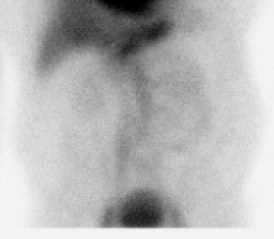
Questions
1. Which ONE of the following is correct?
A. The study is positive for gastrointestinal bleed.
B. The study is complete and is negative for gastrointestinal bleed.
C. The best next course of action is immediate catheter angiography.
D. The activity overlying the central pelvis is likely bladder.
E. Review of the cine images would probably help greatly in this case.
2. Regarding the technical aspects of gastrointestinal bleed scintigraphy, which ONE of the following is correct?
A. Sulfur colloid may be used as an alternative agent.
B. For a study that is clearly positive within the first hour, delayed imaging at 4 to 8 hours is still usually helpful.
C. Barium within loops of bowel does not pose a problem.
D. Delayed imaging up to 24 hours is often helpful at localizing the site of bleeding.
E. If the Ultra tag kit (Mallinckrodt Pharmaceuticals, Dublin, Ireland) is not available, the in vivo method of red blood cell labeling is a good option.
3. Regarding the diagnostic efficacy of gastrointestinal bleed scans, which ONE of the following is correct?
A. Gastrointestinal bleed scans have 93% sensitivity and 95% specificity.
B. Gastrointestinal bleeding scintigraphy is of little value unless positive studies are followed with an angiogram.
C. Diffuse activity in the stomach is usually pathologic.
D. Nonbowel causes of active bleeding cannot be identified with a tagged red blood cell gastrointestinal bleed scan.
E. A gastrointestinal bleed scan is of little value for an upper gastrointestinal bleed.
Answers and Explanations
Question 1
D. Correct! The activity overlying the central pelvis is likely bladder. The key point is that normal bladder activity (or vascular blush from the penis or uterus) may mask the central lower pelvis assessment.
Other choices and discussion
A. No gastrointestinal (GI) bleed is identified at this point.
B. Although there is no GI bleed seen, the study is not complete. Imaging should be obtained for at least 60 minutes.
C. The best next move is delayed images. If the study becomes positive for GI bleed, catheter angiography might then be indicated. Angiography is not indicated after a negative GI bleed scan.
E. Although review of the cine images is routinely advised, there is no suggestion of even subtle bleeding in the test case. In this particular case, cine would be very unlikely to reveal bleeding.
Question 2
A. Correct! The advantages of the sulfur colloid GI bleed scan include that manipulating the patient’s blood is not required and the images themselves suffer less from confounding background uptake. The main disadvantage of the sulfur colloid GI bleed scan is the decreased sensitivity, as sulfur colloid requires even more brisk bleeding for detection. This limitation occurs because the liver and spleen rapidly extract the sulfur colloid (within about 20 minutes), and repeat injections may be required. Numerous comparative studies have confirmed the superiority of tagged RBC scans to sulfur colloid GI bleed scans.
Other choices and discussion
B. A positive study that identifies and localizes the bleed within 1 hour is complete. Further imaging would only serve to delay catheter angiography/other definitive therapy.
C. Barium is not an absolute contraindication, but may cause unwanted photopenic defects.
D. Delayed imaging up to 24 hours is often advised to confirm that a bleed has occurred. However, a 24-hour image is usually not capable of localizing the site of the bleed.
E. When compared to other scintigraphic uses for tagged red blood cells (i.e., multigated acquisition scan, liver hemangioma scan, or splenic scan with heat-damaged red blood cell scan), the GI bleed scan requires the best tag available. This is because free pertechnetate in the stomach and the genitourinary system is quite problematic and often results in false-positive GI bleed scan studies. The in vivo method of labeling RBC or a sulfur colloid scan are options for patients who will not accept the injection of blood.
Question 3
A. Correct! GI bleed scans have 93% sensitivity and 95% specificity for detecting bleeding. This data refers to mid- or lower GI bleeds. The most common site for lower GI bleed is the colon.
Other choices and discussion
B. Even if catheter angiography is not performed, scintigraphy remains useful to make the diagnosis, to stratify risk, and to shape therapy/plan for definitive procedures based on location and rapidity of bleeding.
C. Diffuse activity in the stomach is usually the result of free pertechnetate. By the time scintigraphy is performed, most patients have already had a nasogastric tube placed, which should be able to exclude gastric bleeding. Gastritis could mimic free pertechnetate on a GI bleed scan and is difficult to exclude. Blood is nearly always mobile, so check for movement over time.
D. The radiotracer labels all the blood in the body, so any abnormal accumulation would theoretically be seen. However, bleeding areas that do not reach the GI tract may be more difficult to identify, as the GI tract affords easy visualization through mobility. For example, an active psoas bleed might appear as focal nonmobile accumulation of radiotracer. But keep in mind that tagged RBC scans may be used to detect occult bleeding elsewhere in the body.
E. Although this study is typically performed to assess mid- or lower GI bleeding, the scan is capable of detecting upper GI bleeding. Usually this is not needed, however, as nasogastric lavage is typically performed immediately, followed by endoscopy for suspected upper GI bleed.
Suggested Readings
Dam HQ, Brandon DC, Grantham VV, Hilson AJ, Howarth DM, Maurer AH, et al. The SNMMI Procedure Standard/EANM Practice Guideline for Gastrointestinal Bleeding Scintigraphy 2.0. J Nucl Med Tech 2014;42(4):308–317 Zuckier LS. Acute gastrointestinal bleeding. Semin Nucl Med 2003;33(4):297–231Top Tips
The three key criteria for diagnosing an active lower GI bleed on a GI bleed scan include activity outside of the expected anatomic blood pool, a change in intensity of that activity on consecutive images, and movement of that activity.
When fixed and diffuse gastric activity is seen, consider taking a quick anterior spot neck image. If you see salivary and thyroid uptake, then free pertechnetate must be present, which also explains the gastric activity.
Distal colonic blood is an exception to the rule of mobility and may not move.
Essentials 5
Case
A 51-year-old with multigated acquisition scan prechemotherapy. Current left ventricular ejection fraction is 48%. Previous left ventricular ejection fraction was 58%.
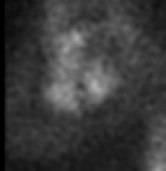
Questions
1. Which of the following are possible causes of this decrease? (Select ALL that apply.)
A. Chemotherapy
B. Heparin use
C. Arrhythmia
D. Technical error, with the region of interest including too much left atrium
E. Technical error, with left ventricular ejection fraction assessment based on the left anterior oblique view
2. Regarding technetium-99m labeling of red blood cells for multigated acquisition scans, which ONE of the following is the best answer?
A. The highest possible level of labeling is needed for a multigated acquisition scan.
B. The Ultra tag kit (Mallinckrodt Pharmaceuticals, Dublin, Ireland) yields 85% labeling efficiency.
C. To perform the highest yield tag, inject stannous ion, wait 15 minutes, and then inject Tc-99m pertechnetate.
D. Suboptimal labeling may result from recent blood transfusions, abnormalities of stannous ion preparation, or anemia.
E. Use of stannous pyrophosphate is optional.
3. Regarding multigated acquisition scanning, which ONE of the following is the best answer?
A. Multigated acquisition and myocardial perfusion imaging are equally accurate in assessing left ventricular ejection fraction.
B. Compared to echocardiography, a multigated acquisition scan is more difficult to perform in pulmonary patients.
C. Oncologists will often alter treatment based on an absolute drop in left ventricular ejection fraction of > 10%.
D. Left ventricular ejection fraction is the only parameter needed for a good multigated acquisition interpretation.
E. With a multigated acquisition scan, the left ventricular ejection fraction is calculated as follows: EF = (ES − ED)/ES.
Answers and Explanations
Question 1
A. Correct! The most common cardiotoxic medications are used to treat breast cancer and lymphoma. Adriamycin (doxorubicin) results in cumulative toxicity and Herceptin (trastuzumab) results in noncumulative toxicity.
B. Correct! Heparin can reduce labeling efficiency, increase free pertechnetate, increase background activity, and decrease the accuracy of the LVEF. Other problematic medications include some antibiotics, anticonvulsants, antihypertensives, and anti-inflammatory agents.
C. Correct! Arrhythmias can impair the accuracy of a MUGA scan. This scan requires gating with the cardiac cycle, and moderate disturbances in rhythm will cause inaccuracies. For quality control, look for rejected beats. Greater than 10% rejected beats (from preventricular contractions or rapid atrial fibrillation with irregular ventricle response) could cause errors and are a red flag. The time activity curve should look the same at the end as it did at the beginning. Too many rejected beats cause a falloff in counts at the end at a much greater rate.
D. Correct! A common problem with MUGA scanning is unwanted inclusion of the left atrium in the region of interest. Normally, the left atrium is posterior to the left ventricle, but when the left atrium is enlarged, its counts are included in the calculation, and this falsely lowers the ejection fraction.
Other choice and discussion
E. The left anterior oblique (LAO) is actually the view that is typically used to measure the LVEF. The three standard views for a MUGA include the anterior, the anterior 45-degree oblique (LAO), and the left lateral. The LAO is also known as the “best septal” as it optimally depicts the intraventricular septum and allows for the most accurate view for LVEF calculation.
Question 2
D. Correct! Suboptimal labeling may result from recent blood transfusions, abnormalities of stannous ion preparation, or anemia. To perform a MUGA scan, an exhaustive medication scrutiny is not needed routinely, but if there is a discrepancy in LVEF between serial studies that does not seem to make sense, keep in mind that there is a long list of potential explanations.
Other choices and discussion
A. The highest level of tag is needed for a gastrointestinal bleed scan but not for a MUGA scan. Of course, better tags are always more optimal, but for the majority of MUGA scan patients, adequate tagging is achieved even with the lowest level of efficiency, which is the in vivo method.
B. The Ultra tag kit yields 98% labeling efficiency, “in vivo” yields 80% labeling efficiency, and “modified in vivo” yields 85 to 90% labeling efficiency.
C. To perform the lowest yield tag, inject stannous ion, wait 15 minutes, and then inject technetium-99m pertechnetate. This describes the “in vivo” method. In patients with renal failure or receiving full-dose heparin therapy, the stannous dose may need to be increased.
E. All methods of labeling require stannous pyrophosphate to “pre-tin” the red blood cells, which permits binding of the pertechnetate to the beta chain of the hemoglobin molecule.
Question 3
C. Correct! Oncologists will often alter treatment based on an absolute drop in LVEF of > 10%. Typical oncology management of cardiotoxicity:
If the patient has a normal baseline LVEF of > 50%: moderate toxicity is defined as a decline of > 10% in absolute LVEF, with a final LVEF of < 50%.
If the patient has an abnormal baseline LVEF of 30 to 50%: a study is performed before each dose. Doxorubicin is stopped with an absolute decrease in LVEF of 10% or a final LVEF of 30% or less.
If the patient has an abnormal baseline LVEF of < 30%: medication is not started.
With Adriamycin, one-third of patients develop cardiotoxicity with cumulative doses > 550 mg/m2.
Other choices and discussion
A. MUGA is more accurate than myocardial perfusion imaging in assessing LVEF. The basic principle for a MUGA scan is that count rate is proportional to ventricular volume. MUGA and echocardiography are similar in accuracy.
B. Compared to echocardiography, a MUGA scan is easier to perform in pulmonary patients.
D. The following should all be assessed when interpreting a MUGA scan: contractility, global and regional wall abnormalities, cardiac chamber size, and extracardiac pathology such as aneurysm or pericardial effusion. Wall motion abnormalities should also be characterized. Absent wall motion is akinetic, decreased wall motion is hypokinetic, and paradoxical wall motion (seen with aneurysm) is dyskinetic.
E. With a MUGA scan, the LVEF is calculated as follows: EF = (ED − ES)/ED. Background activity must first be subtracted from ED and ES counts.
Suggested Readings
Skrypniuk JV, Bailey D, Cosgriff PS, Fleming JS, Houston AS, Jarritt PH, et al. UK audit of left ventricular ejection fraction estimation from equilibrium ECG gated blood pool images. Nucl Med Commun 2005;26:205–215Top Tips
Physicians checking MUGA scans should confirm a good photopenic septum.
Falsely elevated LVEF: poor atrial or ventricular separation, falsely high background, ROI at end systole that cuts off a portion of the left ventricle.
Falsely decreased LVEF: falsely low background leading to insufficient background subtraction, end diastolic ROI that includes a portion of the left ventricle, and end diastolic ROI that includes atrial activity.
Essentials 6
Questions
1. Which ONE of the following diagnoses is correct?
A. Multicystic dysplastic left kidney
B. Limited study because of poor renal function
C. Mechanically obstructed left kidney
D. Dilated, but not mechanically obstructed, left kidney
E. Essentially normal study
2. Regarding Lasix renal scintigraphy interpretation, which ONE of the following is correct?
A. A half time (T ½) of > 20 minutes suggests mechanical obstruction.
B. A T ½ of 15 to 20 minutes is normal.
C. Lasix scans remain very effective with marked renal dysfunction.
D. Lasix renal scans are particularly accurate in the very young patient.
E. Unilateral renal obstruction often results in a limited study bilaterally.
3. Regarding technical tips for performing Lasix scintigraphy, which ONE of the following is correct?
A. Nephrostomy tube patients should have the tube clamped before scanning.
B. Voiding before the scan is optional.
C. The standard Lasix dose for all patients is 20 mg.
D. It is crucial to delay Lasix administration until at least 10 minutes postradiopharmaceutical.
E. The half time (T ½) should always be calculated after Lasix administration.
Answers and Explanations
Question 1
C. Correct! There is poor excretion on the left from the collecting system despite Lasix administration. This is reflected on the time activity curve, with an initial positive slope that remains horizontal. This is the typical appearance of a mechanical obstruction.
Other choices and discussion
A. With multicystic dysplastic kidney, multiple cysts replace part or all of the normally functioning renal tissue. Multicystic dysplastic kidney is found in young children, and the affected kidney has usually either completely regressed or is severely atrophic by adulthood.
B. Although we are not given the patient’s serum creatinine, the target-to-background ratio appears satisfactory (i.e., the visual quality of the study is good). In addition, the bladder and collecting systems are promptly seen. These findings suggest normal renal function.
D. If the left kidney was dilated, but not mechanically obstructed, the kidney would be abnormal prior to Lasix, but would promptly excrete after Lasix.
E. At the very least, we can easily see the asymmetry between the kidneys. This is not normal.
Question 2
A. Correct! A T ½ of > 20 minutes suggests mechanical obstruction. After an anatomic study (ultrasound, computed tomography, or magnetic resonance imaging) demonstrates hydronephrosis, the Lasix renal scan is performed to determine the functional significance. (In the past, the invasive Whitaker test was used for this purpose.) Lasix is usually administered after activity is seen in the collecting system. If there is a brisk response to the Lasix, then there is no high-grade mechanical obstruction. Unlike an intravenous pyelogram or computed tomography, the renal scan may be numerically quantified.
Other choices and discussion
B. The T ½ quantifies the rate of excretion from the collecting system. Most nuclear medicine experts believe that a T ½ of < 10 minutes is normal, 10 to 20 minutes is indeterminate, and > 20 minutes is consistent with mechanical obstruction. Some physicians use a T ½ of < 15 minutes as normal.
C. Poor function may render the Lasix challenge nondiagnostic. As a general guideline, creatinine values above 3.0 often result in extremely limited studies.
D. Assessing hydronephrosis in a young child (aged 0 to 2 years) with Lasix scintigraphy may result in a false-positive study because of renal immaturity. Other causes of false-positive studies include partial obstruction, bladder overfilling, renal insufficiency, and longstanding capacious systems.
E. Unilateral renal impairment does not usually cause a rise of serum creatinine, as long as the contralateral kidney is normal. On occasion, acute renal insufficiency does result from unilateral stone-related obstruction, but that is the exception, not the rule.
Question 3
A. Correct! Nephrostomy tube patients should have the tube clamped before scanning. Otherwise, the tracer will be excreted (through the path of least resistance) into the tube. This could mimic “good excretion,” even if the collecting system is actually blocked.
Other choices and discussion
B. A distended bladder may cause a false-positive study. Voiding before the scan is standard.
C. A sliding scale of diuretic based on the patient’s serum creatinine is helpful in eliciting a response to Lasix. Sliding scale as follows: If the creatinine (Cr) is 1.0, give 20 mg Lasix. If Cr is 1.5, give 40 mg. If Cr is 2.0, give 60 mg. If Cr is 3.0, give 80 mg.
D. The timing of the Lasix administration after the radiopharmaceutical is not critical. In fact, some clinics use the “F-15 renogram,” in which the Lasix is actually given 15 minutes before the radiotracer is injected.
E. Particularly in healthy patients, the radiotracer may excrete early on, even before Lasix is administered. In those cases, the T ½ should be calculated prior to Lasix administration. Make sure to take the extra step of visually correlating the computergenerated T ½ with the time activity curve.
Suggested Readings
Blickman JG, Parker BR, Barnes PD. Pediatric Radiology, The Requisites. Maryland Heights, MO: Mosby Inc.; 2009 Conway JJ. “Well-tempered” diuresis renography: its historical development, physiological and technical pitfalls, and standardized technique protocol. Semin Nucl Med 1992;22:74–84Top Tips
Calculate the T ½ at the steepest part of the curve. This is usually after Lasix, but may occur prior to Lasix.
The region of interest to assess response to Lasix should include the intrarenal collecting system and renal pelvis.
Camera-based clearance measurements are considered precise, but not necessarily very accurate. This means that although the calculated numerical values like glomerular filtration rate and effective renal plasma flow may not be correct, serial studies are useful in determining progression or improvement in disease.
Essentials 7
Questions
1. Which ONE of the following is correct?
A. Curve A is a normal solid phase gastric emptying curve.
B. Curve B is a normal liquid phase gastric emptying curve.
C. The actual images offer no diagnostic value.
D. The normal solid gastric emptying half time is < 90 minutes.
E. The normal liquid gastric emptying half time is < 23 minutes.
2. Regarding technique of gastric emptying studies, which ONE of the following is correct?
A. The consensus gastric emptying paper permits the use of any solid food, provided it can be bound to technetium.
B. Patient positioning affects the rate of emptying.
C. There is no real downside to performing simultaneous liquid and solid phase imaging using two different radiopharmaceuticals.
D. A single-headed gamma camera precludes the calculation of a geometric mean.
E. If a patient eats only half of the meal, but the scan results are normal, the study should simply be reported as normal.
3. Regarding the role of gastric emptying, which ONE of the following is correct?
A. Scintigraphy can usually differentiate a physiologic from an anatomic cause of delayed emptying.
B. Gastric retention of > 10% of the meal at 4 hours is abnormal, and this is the single best discriminator of normal and abnormal motility.
C. It is rare for the 4-hour data to detect delayed emptying that is not already seen at 2 hours.
D. The downside of the new consensus protocol is that it is more time-consuming and results in less patient throughput than the old way.
E. As liquid is less sensitive for the detection of delayed gastric emptying, if the solid study is normal, liquid assessment is not necessary.
Answers and Explanations
Question 1
E. Correct! The normal liquid gastric emptying half time is < 23 minutes. Although there is no recent consensus paper for liquids, this value is generally considered well established. As liquids normally empty rapidly, a liquid study should only require a maximum of 30 minutes of continuous imaging.
Other choices and discussion
A. Curve A is a normal liquid phase gastric emptying curve. Normally, a liquid curve is monoexponential. The larger the volume, the faster the emptying.
B. Curve B is a normal solid phase gastric emptying curve. Normally, a solid curve is biphasic. Solid emptying begins with a lag phase of 5 to 20 minutes (for grinding food into small particles). Then, the curve becomes linear.
C. The actual images are useful for quality control, a limited anatomic assessment, and to exclude reflux or aspiration.
D. A multispecialty consensus paper was established in 2008 with the following criteria: 1 hour > 10% emptying is normal; 2 hours > 40% emptying is normal; 4 hours > 90% emptying is normal; emptying > 70% at 1 hour is rapid. (Prior to the 2008 consensus, a half time of < 90 minutes was commonly used as normal.) Gastric motility scintigraphy is the gold standard for assessing the rate of gastric emptying.
Question 2
B. Correct! Emptying occurs from fastest to slowest, as follows: standing, then sitting, and then supine. Per the 2008 consensus, upright position imaging is preferred, but either upright or supine positioning is acceptable.
Other choices and discussion
A. The consensus protocol specifies the meal, which includes a low-fat egg white (or egg substitute) meal, toast, jam or jelly, and water. Alternative methods as requested by referring services may be performed and reported, but the conclusions are less clear, as these do not follow the consensus methods. Images are obtained at 0, 1, 2, and 4 hours.
C. There are several downsides to performing simultaneous liquid and solid phase imaging. From a mechanical perspective, the liquid will make the solid “less solid,” and the solid will make the liquid “less liquid.” Additionally, because of differing photopeaks, there may be downscatter (or even upscatter). Indium-111 has 171 and 247 keV photopeaks, whereas technetium-99m has a 140 keV photopeak. Advantages of dual simultaneous scintigraphy include both patient convenience and the ability to perform delayed intestinal scintigraphy (because of the indium tracer), which has recently become somewhat more popular.
D. The geometric mean with anterior and posterior images is best obtained with dual-headed cameras but can also be obtained with sequential anterior and posterior single-headed camera images.
The geometric mean is the most commonly used and the most accurate method of count calculation in nuclear medicine and is the square root of the (counts anterior × counts posterior).
E. If less than the whole meal is ingested, a disclaimer should be included in the report.
Question 3
B. Correct! Gastric retention of > 10% of the meal at 4 hours is abnormal, and this is the single best discriminator of normal and abnormal motility.
Normal limits for gastric retention are as follows. Lower limits (a lower value suggests rapid emptying): 0.5 hour: 70%; 1 hour: 30%. Upper limits (a higher value suggests delayed emptying): 1 hour: 90%; 2 hours: 60%; 3 hours: 30%; 4 hours: 10%.
Note that “retention” is just another way to view the same findings of “percent emptied,” described in question 1.
Other choices and discussion
A. The strength of the gastric emptying study is the ability to identify and quantify the delayed emptying. The weakness is the lack of anatomy. If indicated, endoscopy may be needed.
C. The 4-hour image picks up 30% more delayed gastric emptying than does the 2-hour image alone. Of note, the test can be stopped at 2 hours if normal 4-hour values are achieved.
D. The new protocol is more efficient than the old protocol. Multiple (five or six patients) can be imaged during this time, and this can help with scheduling.
E. In the past, liquid assessment was considered less sensitive. That is now known to be false. A total of 30% of patients’ delayed gastric emptying will only be detected with liquid gastric emptying.
Suggested Readings
American College of Radiology. ACR–SPR practice parameter for the performance of gastrointestinal scintigraphy. Revised 2015. Accessed June 2016. http://www.acr.org/~/media/26E5C0B4D8C2471FA7229E7B3B25DFF2.pdfTop Tips
Because liquid gastric emptying is typically rapid, small bowel overlap may erroneously “delay” gastric emptying time, and the images should be inspected to exclude this possibility.
A patient with a percutaneous endoscopic gastrostomy tube may have a gastric emptying study performed directly through the percutaneous endoscopic gastrostomy tube.
The best method for gastric emptying assessment utilizes anterior and posterior imaging with a geometric mean calculation.
Essentials 8
Questions
1. Which ONE of the following is the most likely diagnosis?
A. Bone infarct
B. Sclerotic metastasis
C. Enchondroma
D. Low-grade chondrosarcoma
E. Benign cyst status post therapy
2. Regarding bone scan and bone lesions on plain film, which ONE of the following is correct?
A. Bone islands are always normal on bone scan.
B. Bone scans are usually normal in patients with multiple myeloma.
C. The main utility for a bone scan in the assessment of a bone lesion is to determine the grade of malignancy.
D. Lack of bone scan uptake for a sclerotic or chondrous lesion strongly suggests benignity.
E. One benign bone lesion that is often very hot on bone scan is a nonossifying fibroma.
3. Regarding bone scintigraphy, which ONE of the following is correct?
A. Progression of metastatic disease is best differentiated from the “flare phenomenon” on bone scan by demonstration of new lesions.
B. Isolated sternal uptake in patients with breast cancer is very likely benign.
C. Bilateral axillary uptake is usually clinically insignificant.
D. Cardiac uptake could not result from a recent Cardiolyte (Lantheus Medical Imaging, Inc., Billerica, MA) study as the two tests use different photopeaks.
E. Bone scan is more sensitive for lytic bone metastases than for sclerotic bone metastases.
Answers and Explanations
Question 1
D. Correct! This is a low-grade chondrosarcoma. The plain film suggests either enchondroma or low-grade chondrosarcoma. With chondrosarcoma, the plain film may appear aggressive, with deep endosteal scalloping, lytic components, pathologic fracture, and soft tissue extension (none of which are demonstrated in this case). However, the bone scan shows intense uptake, and significant bone scan uptake with a chondroid lesion should always raise concern for an aggressive process.
Other choices and discussion
A. Although chondroid lesions and infarcts may be difficult to differentiate from each other on plain film, the test case depicts “rings and arcs.” This is typical of a chondroid lesion and would not be seen with an osteoid-forming process. Infarcts often have well-defined sclerotic and serpiginous borders. On bone scan, infarcts demonstrate mild to moderate uptake, unless imaged very early in the disease (rare), in which case a photopenic defect is seen.
B. The intensity of uptake on bone scan in the test case is typical of a sclerotic metastatic lesion, but the unifocality, coupled with the plain film findings of a chondroid lesion, makes metastasis less likely.
C. The plain film findings do support a chondroid lesion, but the bone scan findings would be atypical for an enchondroma. Benign bone lesions (such as enchondromas) typically have little or no bone scan uptake. A total of 20% of enchondromas demonstrate mild uptake, and a very small percent of enchondromas do demonstrate more intense uptake.
E. Bone cysts do occur in the metaphysis and may undergo treatment with curettage and bone grafting, but are commonly seen in the first and second decades. Untreated bone cysts show little if any peripheral uptake. Had there been surgery with bone chips, some uptake on bone scan might be seen, but intense uptake would be unlikely.
Question 2
D. Correct! Lack of uptake for a sclerotic or chondroid lesion is very reassuring for benignity. Moderate uptake is indeterminate. Intense uptake is concerning for an aggressive process, although benign lesions may occasionally show intense uptake.
Other choices and discussion
A. Bone islands (enostosis) are normal compact bone within cancellous bone. These may be confused on plain film with metastases or osteosarcoma, and bone scan can be very helpful in distinguishing, as bone islands are typically not avid on bone scan. However, a small percentage of biopsy proven bone islands have demonstrated mild activity on bone scan.
B. Many myeloma lesions are normal on bone scan. However, the majority of patients with myeloma will have at least one area of abnormal uptake on whole body bone scan.
C. The main utility for a bone scan in the assessment of a bone lesion is (1) to determine the degree of uptake (which is often helpful in distinguishing benign from malignant) and (2) to assess for multifocality. The whole body assessment is a great strength of the bone scan.
E. Nonossifying fibroma is typically not very avid on bone scan. Three benign bone lesions known to have high uptake on bone scan include fibrous dysplasia, osteoid osteoma, and giant cell tumor.
Question 3
A. Correct! The flare phenomenon reflects healing, but presents on bone scan as increased osteoblastic activity at metastatic sites after initiation of treatment. This can last for 6 months. Flare can cause pain, which adds confusion. Computed tomography shows corresponding healing sclerosis. Demonstration of new lesions is helpful in suggesting progression of disease (rather than flare).
Other choices and discussion
B. Isolated sternal uptake in a patient with breast cancer is usually the result of metastatic disease. One study of 34 patients with breast cancer and isolated sternal uptake showed that 76% of those lesions representing metastases.
C. Ipsilateral axillary uptake on the side of injection is nearly always clinically insignificant. However, bilateral axillary uptake warrants further evaluation. Various pathologies including metastatic disease, lymphoma, and granulomatous disease may cause accumulation of radiotracer in lymph nodes.
D. Cardiac uptake on a bone scan could result from a recent Cardiolyte study as both studies use technetium-99m as the radiopharmaceutical.
E. Bone scan is more sensitive for sclerotic bone metastases than for lytic bone metastases. The opposite is true for bone lesions on fludeoxyglucose positron emission tomography/computed tomography, which is more sensitive for lytic lesions.
Stay updated, free articles. Join our Telegram channel

Full access? Get Clinical Tree



